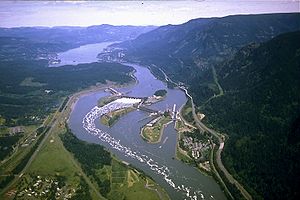When the optional becomes essential: Grants, innovation...and a funny lookin’ fireplace outside Ferraro’s?
Any way you slice it, Rossland’s downtown re-do will be costly. The latest figures from ISL put the project’s first phase at $4.45 million, less approximately $1.4 million from the transportation ministry. The second phase, covering Washington beyond 1st Avenue to Plewman, comes in at $3.8million. Add engineering costs and contingencies and the whole project lands between the $8-9 million mark.
That’s a pretty penny for a pretty design (along with the replacement of old and risk-laden infrastructure), and the city’s ability to pay it is dependent to a huge extent on grant-seeking successes, which hinge in turn on the project’s “innovation” value and importantly, some of the softer features of the plan such as overall appeal and pedestrian-friendliness.
“I wonder if the community is really understanding that the grant applications . . . are dependent on making downtown more pedestrian-friendly,” wondered councillor Jill Spearn at ISL’s presentation to the new city council Monday.
The 7 metre wide stretch of north sidewalk between Washington and Queen is, of course, not written specifically into the two major grant applications, each for $3.9 million to the federal/provincial gas tax fund’s capital innovations and sustainability planning streams. But, “the applications were submitted on the premise that we’re making change and we’re making change for the better,” Jason Ward (the city’s former building inspector now serving as ISL’s Kootenay liaison) reminded council.
The grants were written in the language in the new Official Community Plan, approved in 2008. Essentially, the relevant OCP sections stress a vital, culturally vibrant, and well-utilized downtown with better pedestrian travel flow; “active transportation” or linking Rossland’s outdoor and recreational ethic with the city’s design; and sustainability, which includes a commitment to reduce our environmental footprint in real terms.
So the less immediately essential pieces of the project might also prove the biggest potential attractants for grant funders, making an argument for a “strictly sewers” type approach problematic, ISL representatives argued at Monday’s presentation.
“The grants have an innovation aspect,” said Ward, stressing the need to maintain a focus on specific features in the plan that, if taken out, “could jeopardize the qualification for the grants.” It should be noted here that he was speaking specifically to the gathering space between Washington and Queen, not the fireplace in Harry LeFevre Square, which is absolutely optional.
Innovation examples include the storm water irrigation system for downtown plant life, and in-lane drainage to correct the current ponding issue at curb sides on melt days.
But where the grant possibilities really kick in is around the province’s emphasis on long term integrated community sustainability planning (ICSP), an area where Rossland potentially has a good jump on the competition, i.e. the innumerable other cities applying for the same pots of money, due to a relatively early exercise in sustainability planning through the revised OCP and Visions to Action processes.
“ICSP . . . provides a framework that helps communities plan for their own needs while ensuring that the needs of future generations are also met,” according to the provincial government in a document that continues on to emphasize long term thinking; broad scope including environmental, social and cultural sustainability; planning integration (e.g. between infrastructure needs and social goods); collaboration within communities and between levels of government; and practical implementation.”
Green is always good in grant land: new LED lighting on Columbia Ave. with existing lights repurposed on Washington St. fits here, as does grinding up the old asphalt to grade new downtown off-street parking, and correcting the current water wastage caused by our ancient pipes.
But real strides toward long-term cultural, health and social improvement are clearly key for funders. This stuff is more fuzzily defined. And it’s where potentially silly-seeming concepts like downtown as an “active transportation hub” or “Rossland’s living room,” might actually matter: the streetscape elements that encourage people to gather downtown could end up integral to the project’s overall funding.
An information package with project design details is due to be distributed to citizens in the coming weeks.


























